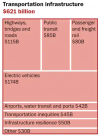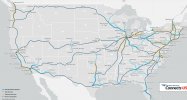nlogax
Established Member
President Biden's long awaited infrastructure plan was unveiled today, a proposal priced at a modest $2 trillion.
As part of that, $621 billion is designated as transportation expenditure. Per the clear breakdown at the Washington Post,

$85 billion will go towards the modernization of mass transit and another $80 billion is being sent the way of Amtrak and freight rail companies to cover a series of projects and overdue permanent way maintenance. Included in that is renewed focus on the Hudson Gateway and the River Tunnel programs to repair and add to the existing tunnels which are in bad need of attention post-Hurricane Sandy. The tunnel project alone is budgeted at $11.6 billion.
Good news, and very much expected from Amtrak Joe. Looking forward to seeing how the rest of that $80 billion is spent outside of the tri-state area and the NEC.
Decent summary here. https://www.nj.com/coronavirus/2021...gateway-tunnel-crucial-to-nj-source-says.html
As part of that, $621 billion is designated as transportation expenditure. Per the clear breakdown at the Washington Post,

$85 billion will go towards the modernization of mass transit and another $80 billion is being sent the way of Amtrak and freight rail companies to cover a series of projects and overdue permanent way maintenance. Included in that is renewed focus on the Hudson Gateway and the River Tunnel programs to repair and add to the existing tunnels which are in bad need of attention post-Hurricane Sandy. The tunnel project alone is budgeted at $11.6 billion.
Good news, and very much expected from Amtrak Joe. Looking forward to seeing how the rest of that $80 billion is spent outside of the tri-state area and the NEC.
Decent summary here. https://www.nj.com/coronavirus/2021...gateway-tunnel-crucial-to-nj-source-says.html
Funding for the long-sought Gateway Tunnel to carry Amtrak and New Jersey Transit trains under the Hudson River will be part of President Joe Biden’s $2 trillion infrastructure proposal, NJ Advance Media has learned.
The plan includes fully funding a backlog of major projects along the Northeast Corridor, including Gateway, according to an administration official. The proposal includes $80 billion for Amtrak and federal railroad grant and loan programs, according to an administration fact sheet.
Last edited:

